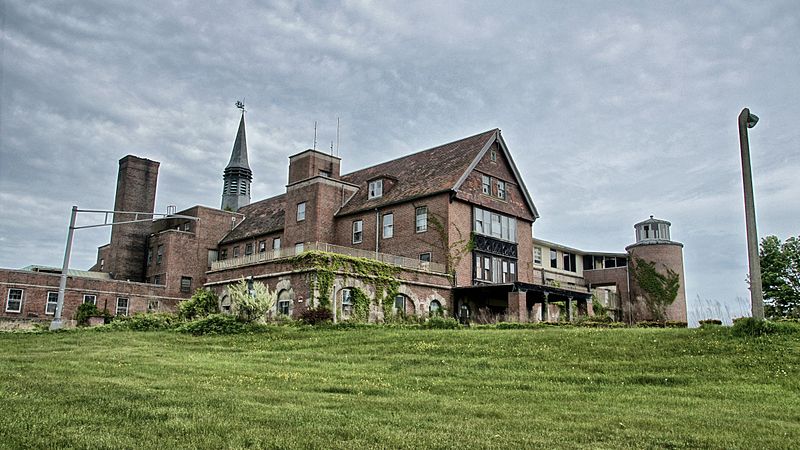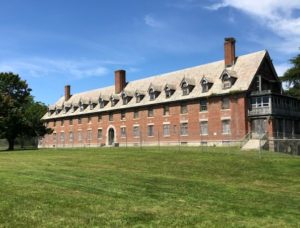By Kelly Marino
Connecticut’s Seaside Sanatorium (also known as “The Seaside” and “Seaside Regional Center”) in Waterford is an often-forgotten gem overlooking the Long Island Sound. Few residents aside from locals are aware of this early 20th-century tuberculosis hospital (turned scenic park) and its significance. After failed attempts at restoration, the buildings remain in disrepair. But at its height, the former tuberculosis sanatorium (later institution for the mentally disabled) boasted of a nationally innovative treatment with natural methods at an architecturally and environmentally splendid facility, the first of its kind in the United States.
The Tuberculosis Threat
As industrialization progressed in the West, tuberculosis became a significant health concern and overcrowded cities allowed the illness to spread. Tuberculosis was the leading killer in Connecticut by the early 20th century, even before illnesses such as cancer, and caused an estimated 1 out of every 20 funerals. The most common form affected the lungs. In children, a version crippled the body and attacked the bones. Variants included a glandular form that aggravated the lymphatic system. Doctors raced for a cure. Some medical professionals believed the best solution was to separate tuberculosis patients and offer them bed rest and proper nutrition in places that seemed like large country homes. There were four such sanatoriums in Connecticut by 1930—one each in Hartford, Norwich, Shelton, and Meriden.
Around 1905, Dr. Stephen J. Maher, head of Connecticut’s Tuberculosis Commission and a New Haven physician, campaigned to get children with non-pulmonary tuberculosis into separate institutions. Research showed children with the bone and glandular forms fared best in places with exposure to sunlight and the breezy, fresh air typical of the oceanfront. This treatment was known as “heliotherapy.” Maher and associates planned a sanatorium on the coast, and by 1918, the first campus opened at the former White Beach Hotel in East Lyme. The property was only about 2.5 acres with 97 feet of beach. Too small to meet the demand, the commission searched for a new location.
Building a Pioneering Model Institution
By the Great Depression, new properties became available, including the Smith-Grimes estate in Waterford. The Tuberculosis Commission purchased over 30 acres from heirs and started construction. They hired nationally known architect Cass Gilbert to be the chief designer with the intention of making the campus look more elegant and domestic and not institutional and hospital-like. The original design included buildings made of granite, brick, tile, and slate with the main hospital building, named after Stephen Maher, constructed in 1934.
The Maher building caught the most sunlight with open terraces and places for patients to sunbathe, such as the 1700-foot sand beach. The Seaside included 195 beds, a school, cafeteria, and dormitories. Children practiced sports, took lessons, enjoyed music, and relaxed at the oceanfront. Most stayed for 6 to 12 months or less.
Medical advances eventually made the sanatorium’s tuberculosis services obsolete, however. Innovations in drug therapy allowed antibiotics to tackle tuberculosis by the late 1940s. The state permitted adults to fill the empty Seaside beds and patients with the pulmonary type of illness. By the 1950s, tuberculosis became largely curable and easier to treat in regular hospitals. Other inventions, such as the use of mobile x-ray machines to detect illness sooner decreased severe sickness, and in 1958, the facility closed.
Repurposing “The Seaside”
The Seaside underwent transitions. From 1959-1961, the campus was a Geriatric Center and from 1961-1996, the Connecticut Department of Mental Retardation used buildings for its new regional center. Beginning in the late 1980s, pushes to de-institutionalize the treatment of people with mental and emotional disabilities caused places such as Seaside Center to permanently shut down. Similar institutions faced charges of mismanagement and mistreatment. Activists urged that patients be moved to group homes.
The Seaside Center sat contested and vacant. The State of Connecticut designated the property as a park in 2014. Some residents criticized the state’s management, however, arguing little effort had been invested in restoration. Advocates for the mentally disabled suggested the state sell the property and put profits into community-based housing for people with disabilities. The state hoped to find a developer to turn the buildings into a resort, keeping the beach open to the public, but in 2019 opted to leave the location as a park with the buildings abandoned, locked, and gated. Renovations needed to the facility have been estimated to require tens of millions of dollars.
Kelly Marino is an Assistant Lecturer of History at Sacred Heart University.










